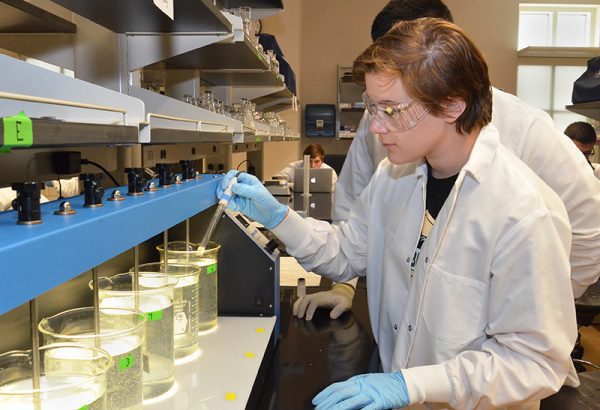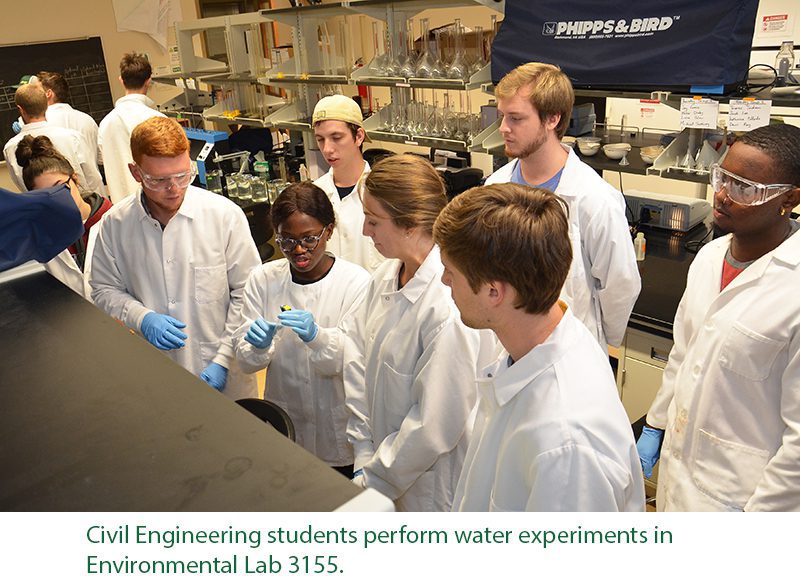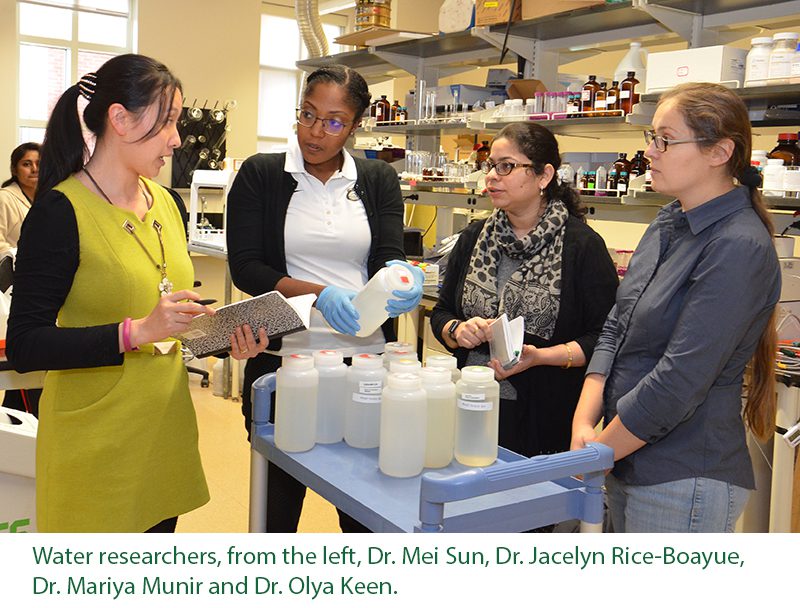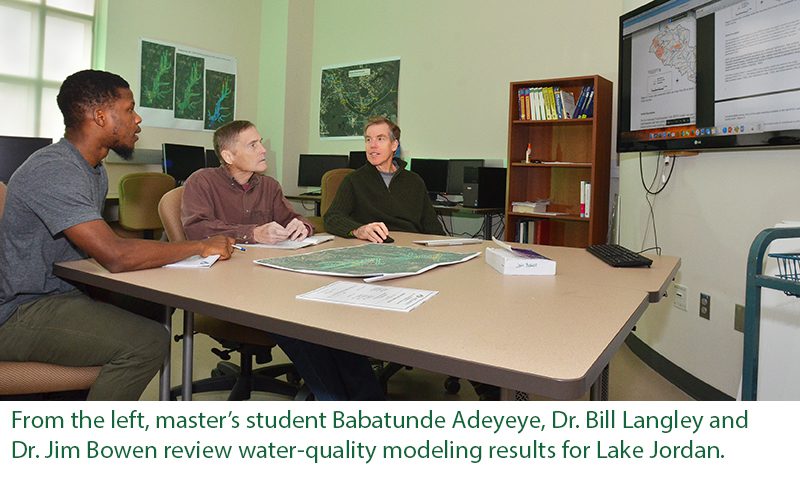Lee College of Engineering’s Many Strengths in Water Research

Water is a precious natural resource, and for decades, researchers in the Lee College of Engineering have been working to protect all types of water in North Carolina. The water research expertise of our faculty has grown over the years, and now encompasses all types of water including surface, ground, drinking, recreational, waste and industrial.
In both the Civil and Environmental Engineering Department, and the Engineering Technology and Construction Management Department, faculty are conducting advanced water research, and educating students who will be future water engineering experts. The research work includes fundamental experimental analysis involving collection, monitoring and laboratory analysis, and also advanced computational modeling to investigate and predict multiple water scenarios.
“This is a nationally-recognized area of excellence for us, all things water,” said Dr. John Daniels, chair of Civil and Environmental Engineering. “There are myriad impacts to water quality, whether ground water or surface water, and many have yet to be defined. We have the ability to identify, measure, model and develop solutions for current and future water impacts. And importantly, we have the wisdom and experience to ensure our solutions are sustainable”.

Lee College of Engineering faculty experts in water research include James Amburgey in drinking and recreational water; Olya Keen, Mariya Munir, Jacelyn Rice-Boayue and Mei Sun in industrial and wastewater; Bill Langley in groundwater; Bill Saunders and Jay Wu in storm water; and Jim Bowen in surface water.
As a group, these faculty members provide the complete spectrum of physio chemical and microbiological evaluation and treatment expertise, inclusive of laboratory, field and numerical modeling capabilities. These capabilities are incredibly important in the study of emerging contaminants, which are chemicals such as pharmaceuticals, personal care products and persistent organic industrial pollutants.
“We need teamwork to deal with emerging contaminants, because all water sources are interrelated,” said Dr. Amburgey. “If you’re looking at the watershed in Charlotte, you also have to look at the source water. Then you have to look at how the water is used and treated, and what happens when it moves downstream. Studying the overall picture takes a lot of expertise and collaboration.”
Dr. Amburgey came to UNC Charlotte in 2005. His research focus is in drinking water and recreational water such as that in swimming pools and hot tubs.
“Most of my work in the last decade has involved recreational water,” Dr. Amburgey said. “Recreational water is not controlled by the EPA like drinking water, so regulations are at the state and county levels. The major issue with recreational water in recent years has been cryptosporidium outbreaks, which cause illness in all 50 states and impact millions of people.”

Dr. James Amburgey and his students are designing and testing better filter systems that use ceramic membranes, and custom combinations of cartridge and sand filters to remove cryptosporidium. “Our job is to analyze what works the best, or if it’s not working figure out how to make it better,” he said. “We also look at what regulations are needed to achieve certain level of crypto removal. We pass this information on to the Center for Disease Control, and then hopefully they work with the states to develop new regulations.”
Regulations and guidelines vary from state to state on issues of emerging contaminants in drinking and wastewater. “As our analytical tools get more sensitive, our understanding of toxicity gets more thorough,” said Dr. Mei Sun. “There is more public concern and interest in controlling contaminants now, because they can pose greater health risks than legacy contaminants.”
Dr. Sun’s lab performs experimental methods in water chemistry, environmental electrochemistry, catalytic chemistry and biogeochemistry to develop solutions for sustainable water. This includes researching treatment technologies; fate, transport and degradation of contaminants; and contaminated subsurface remediation.
“It’s a rewarding area to be involved in,” she said. “The State of North Carolina is investing a lot in water. I have found I can make an impact and it is important, which is very satisfying.”
Collaboration between the college’s water researchers is vital to solving the issues involved in emerging contaminants. “We are looking at broad class of contaminants,” said Dr. Olya Keen. “It is a big puzzle and we are each putting in another piece.”
One field of emerging contaminants Dr. Keen’s lab is looking at is antibiotics and other pharmaceuticals in wastewater. “During chlorine disinfection, pharmaceuticals react with chlorine and form transformation products, some of which may retain the properties of the parent molecule,” Dr. Keen said. “We are testing the properties of the products that form with antibacterial activity assays.”

Dr. Keen and her students are also evaluating various environmental buffers used in potable water reuse, to determine whether the buffers remove or introduce a variety of conventional and emerging contaminants. Another project involves novel biological treatment of landfill leachate.
“Overall, we are looking at how emerging contaminants get in the water, and how to treat them,” Dr. Keen said. “They can’t all be tested for and treated the same way, so we have to develop different solutions. We want to stay ahead of the problem and help determine regulatory concerns.”
Dr. Mariya Munir is hopeful that regulatory policy will reflect public concerns. “My area of research involves creating safer environments for water quality and public health,” she said. “It is a field I am very passionate about, because there are many water quality issues concerning public health, especially in developing countries.”
Dr. Munir’s applies her experience in molecular biology techniques to combat environmental problems related to water and wastewater. Her lab specializes in microbial water quality research; detection, removal and inactivation of emerging biological contaminants; and using Biochar for stormwater pollutant removal. Collaborating with faculty across departments and universities, she is developing strategies to combat the spread of antibiotic resistance in the environment.
Also working in the field of emerging contaminants is Dr. Jacelyn Rice-Boayue. “My research is centered on studying the occurrence, fate and transport of emerging contaminants in the natural and built environment,” she said. “My lab applies modeling, analytical and social science capabilities to monitor, evaluate and improve water quality.”
Having a group of water researchers to collaborate with is important, because of the connectedness of water as it flows downstream, Dr. Rice-Boayue said. “From wastewater treatment plants the water goes into streams, which lead to other streams, rivers and estuaries,” she said. “Everything is connected and this is demonstrated through de facto reuse, which my lab models to assess potential impacts to public and ecological health within the watershed.”
Looking at the overall system has been greatly facilitated by technological advances in computational modeling in the past 20 years. “We have better analytical tools to identify chemicals such as pharmaceuticals,” Dr. Rice Boayue said. “This is very supportive, as we research trends and solutions that can lead to regulatory action at the state level.”

For more than 20 years, Dr. Jim Bowen and his students have been doing analytical modeling of water systems including the Neuss River, the lower Cape Fear Estuary, and Jordan Lake.
“Over the years we have worked on numerous models on the fate and transport of traditional pollutants of lakes, streams and estuaries,” Dr. Bowen said. “The numerical models developed are mechanistically based, which assumes that a complex system can be understood by examining the workings of its individual parts.”
The scenarios Dr. Bowen’s lab model fundamentally involve phytoplankton, to see how it is impacted by pollutants and how this impact affects dissolved oxygen levels in the water.
“Pollutants such as industrial waste and agricultural fertilizer can cause dissolved oxygen to go down,” Dr. Bowen said. “In areas like the lower Cape Fear Estuary, the impacts on dissolved oxygen are of concern to fish and shell fish. To determine the sources and impact of pollutants, we have to consider all the streams flowing into estuary in our computer simulation models.”
The computational models take into account what material is coming into the water body, how long it stays there, and how much constituents react during that time based on temperature and other conditions.
“Based on all the data, we look at what it will take to get things to where they should be,” Dr. Bowen said. “By running thousands of modeling scenarios, we can determine the percentage that variables need to change to improve water conditions to desired levels. These models have been very successful. Based on data from our models, nitrogen loading in the Neuss River was reduced by 30 percent.”
For the future, as Charlotte and North Carolina continue to develop and populations grow, greater demands will be placed on the state’s water resources. At the same time, Lee College of Engineering water researchers will be continuing their research and collaborations to ensure all types of water are safe for people and the environment.